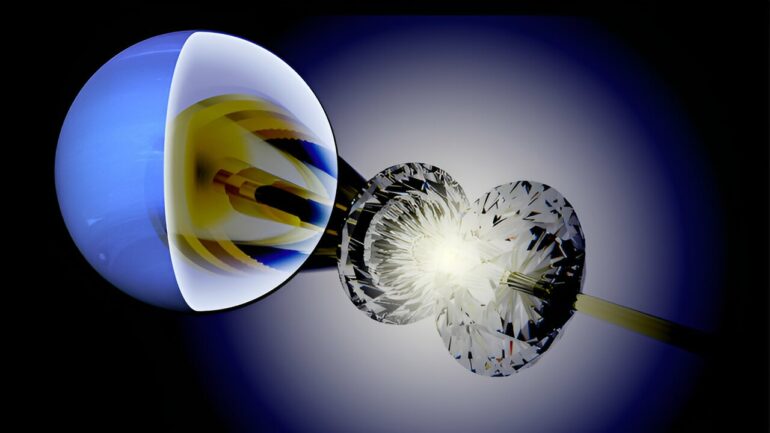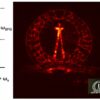In a paper published recently in the Journal of Applied Physics, an international team of scientists from Lawrence Livermore National Laboratory (LLNL), Argonne National Laboratory and Deutsches Elektronen-Synchrotron have developed a new sample configuration that improves the reliability of equation of state measurements in a pressure regime not previously achievable in the diamond anvil cell.
For scale, high-quality static equation-of-state measurements above 5 million atmospheres, up to Neptune’s interior conditions, are attainable with this configuration.
The LLNL development of the toroidal diamond anvil cell has been revolutionary in pushing the static pressure limit in condensed-matter sciences. However, the next crucial step was advancing the sample fabrication for more complex experiments.
Static compression experiments to pressures higher than 300 GPa are extremely challenging, and the compression environment is often not ideal. This new sample package solves this problem, and with an improved compression environment, the quality of equation of state data also is improved.
This work is a major stepping stone toward optimized static compression experiments at these multi-megabar conditions, and provide complementary data to that of gas-gun and NIF experiments conducted at LLNL.
“From here, we can report reliable equation-of-state calibrations of materials at conditions more than two times the pressure that most diamond anvil-cell-derived equations of state have been measured,” said LLNL scientist Claire Zurkowski, first author of the paper.
The team used the LLNL-designed toroidal diamond anvil cell capable of regularly reaching > 300 GPa with a ~ 6 µm diameter sample chamber. This is on the order of 20 times smaller than the width of a human hair. In this small sample chamber, scientists then microfabricated a sample package in a 10-step process whereby the target material is embedded in a uniform capsule of soft metal, which serves as a pressure-transmitting medium.
As samples in the diamond-anvil cell are compressed by the anvils along just one axis, it is critical to redistribute this stress uniformly around the sample material to achieve a reliable equation-of-state measurement. In the case of this study, the soft metal capsule does exactly that, even on a micron scale.
The experiments were conducted at Argonne National Laboratory Sector 16 HPCAT and at Deutsches Elektronen-Synchrotron PETRA-III. While the scientists tested this methodology on molybdenum with a copper pressure-transmitting medium, this sample package can be broadly applied.
“This work only marks the beginning of sample-package microfabrication in the toroidal diamond anvil cell,” Zurkowski said. “We anticipate that this sample-encapsulation method will readily push static equation of state calibrations in physics, chemistry and planetary science materials into the multi-megabar range—conditions where static compression data is very limited at present.”
Co-authors include Rachel Lim, Olivia Pardo, Earl O’Bannon, Per Soderlind and Zsolt Jenei from LLNL and K Glazyrin from Deutsches Elektronen-Synchrotron.
More information:
C. C. Zurkowski et al, Improving equations of state calibrations in the toroidal DAC—The case study of molybdenum, Journal of Applied Physics (2024). DOI: 10.1063/5.0223794
Provided by
Lawrence Livermore National Laboratory
Citation:
Unveiling a novel sample configuration for ultrahigh pressure equation of state calibrations (2024, August 28)



